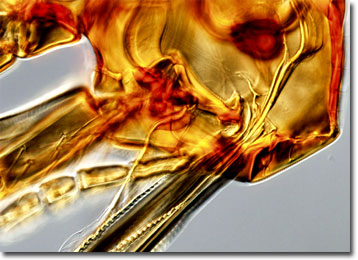Differential Interference Contrast Image Gallery
Human Flea (Pulex irritans)
Over 1,600 species and subspecies of fleas, which are parasites in the insect order Siphonaptera, populate the Earth’s many diverse environments. The human flea, Pulex irritans, is rather rare in modern domestic dwellings, but in former times was a constant cohort to all classes of people.

As is indicated by its common name, the preferred food of Pulex irritans is the blood of humans, although it will feed on other mammals as well. In fact, today the species is most often found on pigs, breeding in their sties profusely. Individuals that work with swine, therefore, are some of the most likely to become infested. Before the development of modern standards in hygiene and laundering, however, human fleas were extremely common, especially in bedding. At one time, the Chinese placed warmed flea traps made of ivory or bamboo between the sheets before going to bed in an attempt to decrease the problem. Also, around the time of the Renaissance, ladies frequently wore fur collars, or cravats, to catch fleas, which could then be removed and shaken out.
The human flea is mainly a nuisance, an enzyme in their saliva producing an allergic reaction in their victims that causes an itching sensation. However, the parasite can also be a vector of a variety of diseases. Though it was not the primary species responsible for spreading the bubonic plague throughout Europe during the Middle Ages, the human flea is capable of transmitting it. The species may also transmit murine typhus, tularemia, and tapeworm, but such occurrences are relatively rare.
